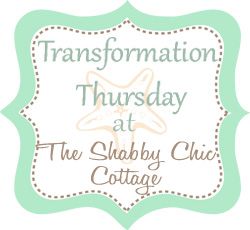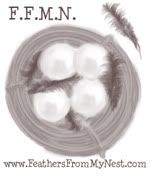Today's Feather:
Make Your Own Cloth Napkins - DIY Tutorial
This project is great for anyone needing everyday napkins or wanting to whip up something cute to give as a HOSTESS GIFT.
CAUTION: Look away all you seamstresses. This tutorial will drive you crazy! As I mentioned before...I am a 'slam bam thank you mam' sewer. I'm not a skilled sewer and I don't know proper techniques. But....I do get the job done which makes me smile. :o)
Material - huh...that was easy!
A quick note on fabric choices. - Stay away from polyester/cottonblends, they are stain magnets. For my everyday napkins I chose a linen material and dyed them brown. Thus far it is my favorite material for napkins. They are sturdy, not bulky and wash well. (Plus linen material is made from the fibers of a flax plant and is significantly more environmentally friendly than cotton. I don't necessarily make my decisions based on environmentally friendly...most of the time it just ends up that way since Natural Living and Thrifty Living usually go hand in hand.) If I'm wanting a decorative print material for holiday napkins I choose regular cotton apparel fabric. This is what I used for my easter napkins in this tutorial. I do personally find this type of material to be a little thin so I usually sew two layers together with cooresponding patterns. I still prefer the functionality of a single layer of linen but these are cute for the occasion.
Steps...
1. Prewash your fabric to preshrink.
I learned this the hard way. Nothing is worse than sewing a project that gets ruined during the first wash.
2. Cut your fabric.
Standard sizes are 12, 14, and 16 inch squares but I like my napkins to be smaller. By making these Easter Napkins a 10x13 size I was able to utilize my fabric a little better as well. These are 'special occasion' napkins so I chose a patterned cotton apparel fabric. This type of fabric is usually thin so I chose to do two layers of fabric to add some thickness. If you do this, cut your fabric with the patters facing each other (inside out) so it will already be lined up when you sit down to your sewing machine.
3. Time to sew.
Make sure your patterns are still facing each other. Sew all the way around your napkin and leave an opening on one of the corners.
Make sure your patterns are still facing each other. Sew all the way around your napkin and leave an opening on one of the corners.
3. Turn your patterns right side out.
Use this hole to turn your fabric right side out. Pay close attention to the corners and turn them out as much as possible.
Use this hole to turn your fabric right side out. Pay close attention to the corners and turn them out as much as possible.
I'm sure there is some savvy way to hand-stitch this seam closed before you do your decorative top stitch. I have no idea how to do that plus I'm ready to get the job done at this point. I simply turn in my edges and top stitch over it. Thus far I have had no problems with this method and I figure if it ever does come open I'll just give it a quick whip in the sewing machine and it will be good as new.
5. Top Stitch. If you've never sewn a top stitch read on....
I start by stitching forward about 1/8 of an inch and back stitching over it to give it strength. I sew over the opening that was turned in and gently keep the remainder of the fabric in place and straight as it runs under the needle. When I get to the corner I stop when the needle is in the fabric, lift the foot of the sewing machine, turn my fabric 90 degrees, lower the foot and stitch on down the other side. At the end, after I have stitched down each side, I back stitch a little again to give my thread strength.
I start by stitching forward about 1/8 of an inch and back stitching over it to give it strength. I sew over the opening that was turned in and gently keep the remainder of the fabric in place and straight as it runs under the needle. When I get to the corner I stop when the needle is in the fabric, lift the foot of the sewing machine, turn my fabric 90 degrees, lower the foot and stitch on down the other side. At the end, after I have stitched down each side, I back stitch a little again to give my thread strength.
Taaa Daaaaaa! Now your done!
Looking for a cute gift?
A set of 4 make a perfect set to share.
With this set I even included 2 smaller 6 inch napkins for the kiddos.
A set of 4 make a perfect set to share.
With this set I even included 2 smaller 6 inch napkins for the kiddos.
Other sewing options are:
- Using a serger on a single layer of linen or cloth terry. This is what I did for my everyday napkins.
- You can also do single layer napkins this way.
Turn the edge of a single layer in 1/4 inch and then 1/4 inch again. Hem down these folds. Sew the first side and then the side directly opposite before moving on to the edges perpendicular to it. Hemming in this order gives a nice little square stitching detail on the corners.
































6 comments:
Thanks for the easy tutorial. I'm a very amateur seamstress as well, so these directions were great! I'm looking forward to trying this project.
I'm glad I'm not the only one who sews this way. Thanks for the tutorial! It's just what I needed.
Did you top stich all the way around or just to close the open corner?
beautiful work, and thank you for teaching me how to do, loved it!
Nicole - stitch all the way around. That holds the layers together, makes it stay as a flat square instead of pouffing out & folding funny.
Start & end in the middle of a side. Much easier than messing with a corner along with the seam allowances, while holding it all together to sew.
Oh, and _PRESS_ once you've topsewn. Makes it look sharp.
And here's an easy way to get the open area to turn under nicely:
start at the cut edge, in the middle of a side,
sew _in_ (toward the center) 0.5" until you get to where you want your seam to be,
stop with the needle down,
turn so you're going along the seam allowance, parallel to the cut edge,
sew around the perimeter until you're several inches from the start,
then make that right-angle turn toward the edge.
So you sort of have an L & a backwards L, with the bottoms connected by going around the napkin and the stems (where you've backstitched) pointing to the edge of the napkin.
When you turn this right side out, the seam in the open part will turn itself in & stay put easily, so you can top stitch & hold it closed.
Post a Comment